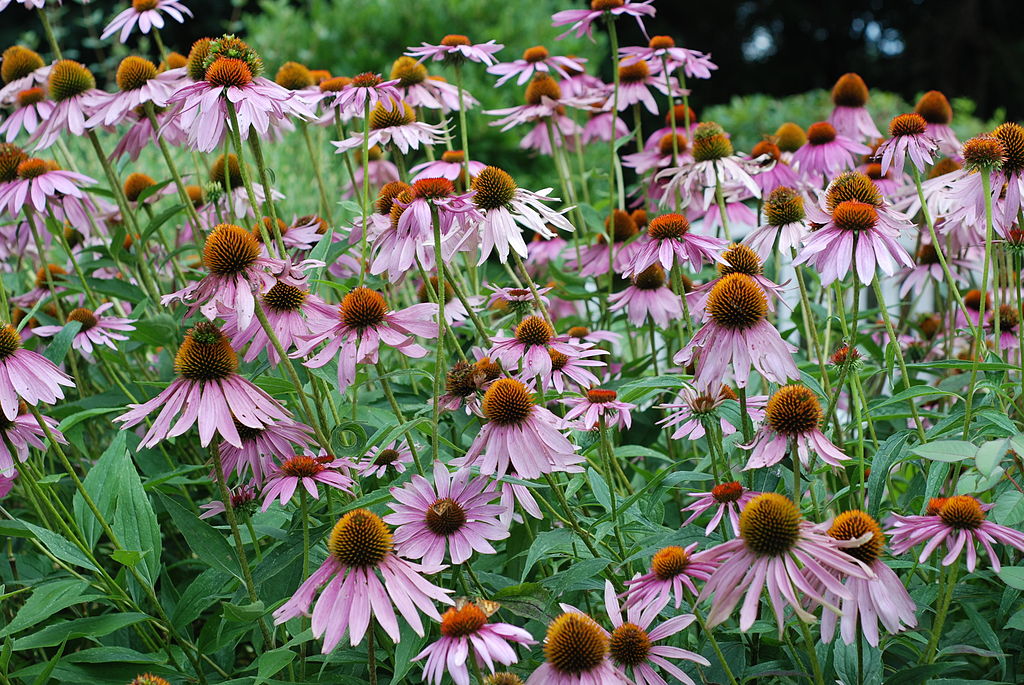Echinacea (Echinacea spp) or purple coneflower is an herb that has become widespread as an ornamental plant thanks to its showy flowers. Normally purple to light lavender in color, hybridizers have developed new cultivars with flowers that range in color from white through yellow to orange and into deep reds.
There are 10 species of echinacea, all native to North America. Many people use echinacea medicinally to prevent colds under the mistaken impression that it strengthens the immune system. This is the result of a misunderstanding between a Swiss maker of supplements and Native Americans. Native Americans used echinacea to treat cold symptoms. The Swiss misinterpreted that to mean it was used to prevent colds. There is no scientific evidence that echinacea prevents colds. There is, however, scientific evidence that Native Americans were right and echinacea alleviates cold and flu symptoms. Interestingly, Plains tribes learned about echinacea by observing elk who seek it out and eat it when they are injured or sick. Their name for it is Elk Root.
Supplements normally contain one of three species of echinacea: the familiar E. purpurea, which most people call Purple Coneflower and grows in the Eastern part the of the US, E. angustifolia, also known as the Narrow Leaved Purple Coneflower which grows in the Great Plains of both the US and Canada, and E. pallida , usually called the Pale Purple Coneflower which grows in the Missippi Valley and southeastern portion of the Great Plains.
Most of us grow E. purpurea, or purple coneflower, in our flower beds and herb gardens. It, along with the other echinacea species, are all members of the sunflower family. The purple coneflower is a perennial hardy from zone 3 through 9. It grows from 2’ to 4’ tall and blooms continuously from mid-summer through fall. You can help your plants produce more blooms by removing the fading flowers before they go to seed. At the end of the season, instead of cutting down the dying flowers, you can leave them to go to seed and either allow them to reseed themselves in your garden or provide a tasty meal for the resident goldfinches. If you plan on saving seed from your plants or allowing them to self-sow in your garden, the new hybrids produce sterile seeds. Only the true E. purpurea will produce viable seeds that you can use to grow new plants.
Purple coneflowers prefer full sun but will tolerate light shade. For best growth, they should get a minimum of 5 hours of sun each day. Less than that and the plants will start to lean as they reach for the sunlight.
Once established, all types of echinacea are drought tolerant. For most of them, it’s due to their long taproot. E. purpurea, lacks the long taproot and has a fibrous root mass instead. It is still drought tolerant and has the added advantage that it is easier to divide than its cousins with the long tap roots. Plants can be divided in either the spring or the fall.
Purple coneflowers are easy to grow from seed. The easiest way to grow them from seed is to simply “plant” the entire flower head after it has produced seed. The drawback to this method is that it results in a lot of seedlings which must be thinned or transplanted. Most people sow individual seeds. It’s best to sow your seeds in the fall because they need a period of cold to germinate.
If you would like to start your seeds indoors in the spring, you will need to mimic that period of cold by using the moist cold stratification method. It sounds much more intimidating than it really is. You merely soak your seeds overnight in water then transfer them to a sealed container which should be kept in your refrigerator for 8 to 10 weeks, mimicking the cold of winter. Then all you have to do is plant them as you would any other seeds that you are starting indoors. Germination should occur in 10 to 14 days.

